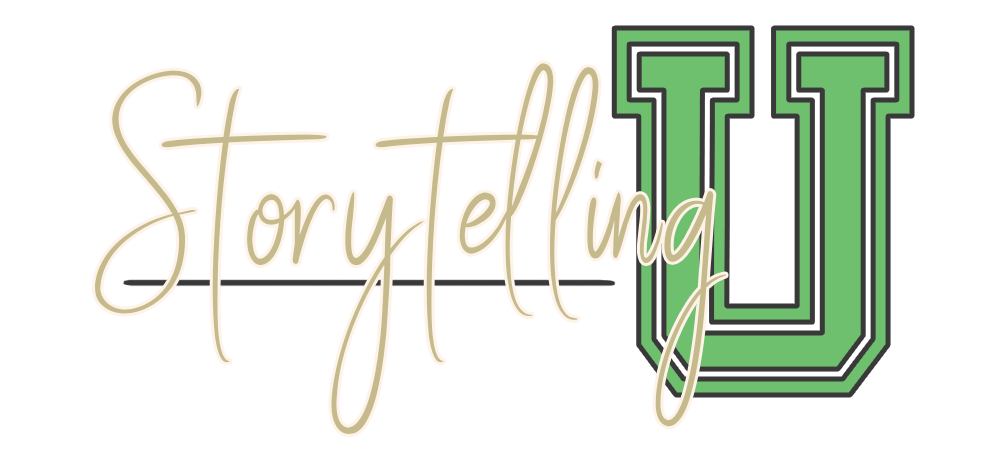What is Storytelling for Business?
The Ultimate Guide to Strategic Storytelling
As author and literary scholar Jonathan Gottschall once said:
“We are, as a species, addicted to story. Even when the body goes to sleep, the mind stays up all night, telling itself stories.”

Gottschall’s message is crystal clear:
Storytelling? It’s fundamental to the human experience.
I concur. And that’s why I believe it’s essential to your business success.
As we’ll go on to discuss, stories are at the heart of any successful business, regardless of niche. They’re captivating and emotive—generously dosed with trust-building potential and primed for boosting monthly sales numbers.
There’s a catch, though.
Storytelling is an art. And, as anyone who recalls their high school art class knows, art can be hard. Leveraging the power of storytelling requires practice, trial-and-error, and a firm grasp of the topic itself.
Unfortunately, the first two requirements fall squarely on your shoulders. But I can certainly help with the latter. In this comprehensive guide, we’ll cover everything from the history of storytelling and the science behind it to the different kinds of business stories and exactly where you should be leveraging those stories. Sound good?
Read on for an ultimate guide to strategic storytelling that’ll take your business communications to the next level.
What Is Storytelling?
Let’s start with a definition. After all, while it might seem obvious (most of us have been reading and hearing stories our entire lives), you must understand what sets business storytelling apart from other forms of communication before you can truly master it.
General Overview
Storytelling is the process of delivering a message to your audience using a narrative approach.
The narratives in question could be based on entirely true events, embellished, or 100% made up. Whatever the case, the art of storytelling involves presenting communications (and the messages therein) in a vivid and compelling way.
That’s the cliff notes version, anyway. If you’d like to learn more about the technical side of storytelling, I cover that in Storytelling Techniques: The Ultimate Guide to Crafting Compelling Stories.
Another thing to keep in mind is that stories come in many forms.
You can tell them via the spoken word (e.g. podcasts and speaking gigs), through your writing (e.g. blog posts and books), and in visual form too (e.g. photos, comic books, videos, GIFs, and memes).
Stories come in all sizes, too—they can be long or short, depending on your communication goals, audience, and storytelling medium. Finally, stories can be overt (e.g. you outline a specific course of events from Point A to Point B), or more subtle in nature (i.e. the story is implicit or perceived, a la the Disaster Girl viral meme).
And business storytelling?
As the name suggests, this is the act of sharing strategic, brand-related stories. Whether you’re recounting your origin story, a customer success story, or highlighting your company culture through employee stories, you’re utilizing the power of narrative to connect with your audience at an emotional level.
The History of Storytelling
The incredible power of storytelling starts to make sense when you appreciate its long and illustrious history. Seriously, storytelling’s old news…but in a good way.
It’s been around for as long as humans have roamed the planet.
It even predates the use of written and spoken language. Paleolithic-era cavemen and women left red ochre palm prints on cave walls, telling the world and generations to come: “I was here.” Evidence shows that ancient cave paintings were also used to communicate messages from one person or group to another.
Following cave art, oral storytelling became a vital form of communication—and has remained so for eons.
Think about it. How would you share important messages before written languages existed? Word-of-mouth’s your only option. Encoding messages in story form is a logical way to make them more memorable and preserve the sentiment for years to come (in fact, when information is presented in story form, it’s 22 times more memorable than facts or stats alone). This process likely gave rise to the many myths and legends we still talk about today.
Once the written language emerged, storytelling naturally migrated there, too. We know that people have been writing stories down for thousands of years—from etchings on the Rosetta Stone to Homer’s epic, “The Iliad” (that’s the Ancient Greek author, Homer, not the Simpson). Indeed, storytelling evolved from the oral to written tradition a very long time ago. The result?
Storytelling is a fundamental part of our shared cultural heritage. It’s been around for—well—ever, shaping our very biology in the process (that’s right, our brains are neurologically wired for stories). In a very literal sense, then, we’re all natural-born storytellers.
Why Use Storytelling?
Okay, so now that we’ve covered the “what,” it’s time for the “why.”
We’ve already shed some light on the value of strategic storytelling, but if you’re still not sure why stories are central to business success, then this is the section for you.
The Benefits of Storytelling
There are several reasons to start incorporating stories into your brand-building endeavors. Here are a few key benefits:
1. Captivate
The Nobel Laureate Herbert A. Simon once noted that “a wealth of information creates a poverty of attention.”
In other words, the more information you have at your fingertips and the more tasks you attempt to juggle at once, the harder it is to pay attention to any single one of them. That’s bad news for marketers in today’s world.
After all, with a smartphone in your pocket, there’s always something to distract you. From TikTok and Instagram to YouTube and Spotify, the demands on your target audience’s attention have never been higher.
And competition for it is fierce as a result.
Thankfully, compelling stories help you break through the noise, stand out from the crowd, and grab your slice of the proverbial pie. For reasons we’ll explore in the next section, people gravitate toward stories naturally.
As personal experience may attest, you can’t help but take note, engage, and feel something when you encounter a good story.
2. Connect
So, stories can give you a captive audience—that’s great news. Yet getting someone’s attention is only part of the struggle.
To really build a successful business, your audience has to trust you as well.
If you’ve ever made a cold call (the horror!), you’ll know what I mean. Without rapport, without a prior relationship—without trust—it can feel nearly impossible to make any headway.
Consumers are tired of being sold to and they’re so accustomed to generic marketing efforts that this approach no longer works as well as it once did.
Herein lies the magic of strategic storytelling. Not only can it help grab someone’s attention, but, when done properly, it can also foster a sense of connection between potential customers and your brand. The key to telling stories that create connection is to make sure your stories are authentic and relatable—people should be able to see themselves in the stories you tell.
To further maximize this connection-building power, focus on the emotional aspects of stories. When humans engage in the storytelling process, our brains release a series of chemicals. One of these chemicals is oxytocin, which helps us feel empathy. That empathy then leads to a sense of affinity and trust.
From the language used to the lessons shared, the best stories are packed full of emotive elements. Whether you make people feel joyful, thoughtful, grateful, or inspired, they’ll connect with your business in a powerful way that helps establish that all-important trust factor.
3. Convert
What do you get when you combine a captive audience that trusts your brand with a winning product or service that solves their problems?
Sales!
Unbelievable as it may sound, increased conversions are linked to sharing great stories. Some studies suggest storytelling can produce a whopping 30% surge in conversions.
That’s because, in a sea of great products and services, it isn’t facts, impressive statistics, or details about your USP that compel consumers to hit the “buy” button.
It’s the connection they feel to your brand, as we covered above. And it’s the persuasive power of stories that paint a picture of what’s possible for consumers when they use your products or services.
Because our brains are wired for stories, our subconscious brain can’t distinguish between fact and fiction. When we watch a movie, for instance, part of our brain thinks that we’re really experiencing the events taking place on-screen. That’s why we cry when our favorite character dies, or why feel-good commercials give us goosebumps.
Stories can literally create a physiological response in humans.
In addition to oxytocin, stories also trigger your brain to release dopamine, which makes you feel pleasure and reward. How cool is it that you can use storytelling to provoke joy in people when they encounter your brand? More on the science of storytelling below.
All of this leads to new customers, increased brand loyalty, and, ultimately, higher profits.
We see this play out all the time on high-converting landing pages. Aside from their eye-catching headlines, slick sales copy, professional images, and first-class calls to action, the best landing pages tell a story.
Come to think of it, the best landing pages tell numerous stories…
They’re everywhere, from the title that explains what consumers stand to gain to the testimonials from satisfied customers. Stories can also appear in the form of the founder’s personal backstory and the copy explaining who the product or service could serve. There might even be an explainer video embedded somewhere on the page.
The end product is a highly optimized landing page that’s rife with conversion potential. And that’s just one way you can use stories to boost your business’s bottom line. You’ll discover more uses later in this guide.

The Science of Storytelling
Think about the last time someone told you a story.
Whether they were recounting a past event or reading from a book, it probably transported you, mentally, to a whole new place. You may have forgotten all about your surroundings and felt utterly immersed in the world they described.
Such is the power of storytelling. And a growing body of scientific research is revealing the brain mechanisms behind the magic.
A study in the Journal of NeuroImage, for example, found that stories triggered a reaction in parts of the brain associated with emotional responses (such as the amygdala), language processing, and even the cue to move your body or take action (i.e. the premotor cortices).

That’s not all, though.
Amazingly, there’s even evidence to suggest that activity in the listener’s brain begins to synchronize, or “couple,” with that of the teller. And, as the listener’s comprehension of the story develops, their brain waves start mirroring the teller’s to an ever greater extent.
That’s right, your brains literally emulate one another. Talk about stepping into someone else’s shoes. This is empathy in action—all thanks to storytelling.
And there’s more.
This post from Forbes does a great job of explaining how compelling stories release three potent neurochemicals into your system: cortisol, dopamine, and oxytocin.
Without delving too deep into the complicated world of brain chemistry, these chemicals lead to greater awareness (i.e. attention and memory), arousal (i.e. pleasure and reward), and empathy, respectively. Importantly, a surge in oxytocin (coupled with cortisol) can also drive action.
The keen-eyed amongst you will have realized how that pertains to the buyer’s journey—or the transition all consumers go through from awareness to consideration and, finally, to making a decision.
To put it another way, stories trigger a neurochemical response that facilitates sales.
So, where does all this leave us?
Ultimately, the research on this topic proves that the power of storytelling for business isn’t just anecdotal—it’s backed by science. There are profound biological mechanisms at play here that make stories so dang impactful and laden with so many benefits.
How to Use Storytelling
Hopefully, the previous sections have made the case for storytelling as a business strategy. Moving on, we’re going to offer some insights on how and where to use stories to their full effect. Let’s kick things off with a few specific ways to leverage stories.
To Establish Your Brand Identity
Of all the areas to employ storytelling, your origin story is arguably the most logical.
This, if you don’t already know, is where you explain to your audience how and why your brand came to exist. It also positions you in the marketplace and helps create a brand identity that sets you apart. After all, there’s one thing you have that nobody else does: your unique story.
Ask yourself:
If you’re struggling for inspiration, consider your favorite superheroes. Each of them has a unique origin story that sets them on their path and ties them to their current mission.
For Batman, it was watching his parents get murdered that motivated him to clean up Gotham’s streets. Iron Man’s story began when millionaire playboy Tony Stark was captured by a warlord and forced to make weapons for him. He built the Iron man suit and committed to fighting crime thereafter.
What about you? Alas, while you might lack the superpowers, there’s sure to be something that prompted and drove you to start your business. Spend some time digging into your “why” and you’re bound to find your origin story.
As a side note, I should point out that storytelling is also an effective way to describe what you stand for as a company. You can weave your values, vision, and mission into your origin story, further endearing you to your target audience.
To Build Relationships
Remember when we talked about stories being like gold dust for forging connections with an audience? And how those connections are a one-way ticket to making sales?
Well, I encourage you to take that information and run with it. Since we’re all natural-born storytellers, you can start using stories to build relationships today. Simply start incorporating stories into your writing, speaking, and content strategy.
For instance, you could share “behind the scenes” videos on social media, blog posts that are full of personality, inspiring customer success stories on your website, and even stories about how you participate in your local community.
Do it right and you’ll soon cultivate that crucial “know-like-trust” factor that’s central to success.
Indeed, storytelling is one of the best tools you have at your disposal. And you don’t even need any fancy equipment to start telling stories—just your brain. Trust me, the more stories you tell, the more open you are, and the more personality you show, the sooner your target audience will come to like, know, and trust you.
To Teach
Stories can also function as teaching aids—especially when you’re trying to explain a new or complex concept, or to illustrate the benefits of certain product features.
Take Aesop’s classic fable, “The Boy Who Cried Wolf.”
You know the one. A bored shepherd boy tricks nearby villagers into thinking a wolf is attacking his flock of sheep. They fall for the ruse and come to his aid, much to his amusement. He does it again a few days later. The same thing happens.
However, at some point, a wolf actually does attack his flock. The boy cries out for help once more, but, assuming it’s another trick, nobody comes to help.
The Boy Who Cried Wolf teaches children about the dangers of lying and the virtues of telling the truth. A simple yet evocative story, it sticks in your memory and serves as a useful point of reference (even into adulthood) if you’re ever tempted to, well…cry wolf.
A small child may not understand the notion of “consequences.” But when you tell a tale that shows them what might come of lying, the abstract becomes more concrete. In essence, storytelling is an effective teaching tool thanks, in part, to the imagery involved.
Because stories paint pictures, they help people visualize what you’re talking about. Make no mistake, this is invaluable. Humans are visual creatures, after all (just consider the age-old expression “a picture is worth a thousand words”). Suddenly, people don’t just hear a stream of words.
They see your point in their mind’s eye.
That’s why it pays to incorporate analogies, metaphors, and real-world examples into your business communications. It makes a massive difference in getting your message across clearly—and getting it to stick in your audience’s brain long after the story’s over.
To Sell

Given what we’ve learned about the potential sales benefits of storytelling, it makes sense to incorporate it into your sales strategy.
Heck, there’s even a term for doing exactly that: storyselling.
For instance, let’s imagine you’re running a webinar and you’re trying to extol the virtues of working with you.
Your audience is much more likely to say “yes” if you can point to past clients—real people just like them—who purchased your course (or attended your latest seminar, or bought your book…) and went on to do great things.
Selling products and services by telling stories—like your origin story—helps humanize the process as well. You’re no longer a faceless brand. Everything feels more personal and relatable.
For consumers, stories can also imbue transactions with a sense of meaning, which makes whatever gizmo they’re about to purchase seem more appealing.
In middle school, buying platform sneakers meant a whole lot more than acquiring protection for your feet (or, more realistically, a rolled ankle). Buying a Subaru means you’re an outdoor adventurer. And wearing Bombas or TOMS means you care about your fellow humans.
Some types of storytelling enhance your credibility, too. Case and point: customer success stories. (Are you starting to grasp how important these little buggers are?) Success stories act as “social proof”—they verify that you’re the real deal.
Where to Use Storytelling
Good news: there’s no real limit to when and where you should incorporate stories into your brand-building efforts. There are, however, a few places that make the most sense. Let’s look at those now.
Social Media Posts
With 58.4% of the global population now using it, social media’s a serious boon for marketers.
It’s also prime territory for storytelling.
Heck, Instagram literally has a “story” feature (aka Instagram Stories), where you can take your followers on a journey throughout your day. Likewise, so does Facebook. TikTok videos, YouTube Shorts, Pinterest Idea Pins, and Instagram Reels provide similar storytelling opportunities.
Ever heard of Elyse Myers? At the time of this writing, she has 5.2 million followers on TikTok alone and 99% (okay, I don’t know the actual percentage) of her videos are simply Elyse telling short stories. So, if you needed more proof that people love stories, there you have it.
There’s almost no limit to what you can do with storytelling on social media. From written posts to elaborate infographics and quick-fire TikTok clips to full-length YouTube documentaries, you can tell stories on whatever platform floats your boat.
Keep in mind that you aren’t always telling stories with the sole purpose of selling.
Far from it. The vast majority of your social media stories should revolve around branding. The focus should be on providing value and cultivating a distinctive brand identity that appeals to your target audience. Remember, you’ve got to build that “know-like-trust” factor before putting on your sales hat.
You might post a funny meme on Facebook that relates to a current event and aligns to your brand values, a Twitter thread detailing your opinion on a topic in your niche, or a TikTok video with a behind-the-scenes look at what happens in your office on any given day.
The stories themselves might not be explicit—they won’t always have a beginning, middle, and end. Yet the content itself will tell a story all the same.
In those examples of possible posts, you’re saying things like:
Email Marketing
You probably know the name Neil Patel. He’s a big name in all things marketing-related, but his emails are particularly effective. Here’s one he sent recently:
Subject: 11 Useful Digital Marketing Tools When You Have No Team
If you don’t have a team to help you that’s okay. You can still get a lot done.
All you have to do is use a few tools to help you out.
Here are 11 tools that can help you out with each marketing channel.
Many of them will automate a lot of your marketing tasks.
Hope it helps.
Cheers,
Neil Patel
With a few short sentences, Patel grabs your attention, promises a relevant outcome, and compels you to click a web link he included on the third line.
Impressive, right?
Note how he’s homed in on a specific sector of his audience as well. This isn’t a message for big corporations and fancy execs; it’s for the small business owners on his email list.
While it may not seem like it, Patel’s telling a story.
Again, it isn’t an explicit “once upon a time” type of narrative. But it’s a story nonetheless. He’s saying: “The little guy can win too—here’s how.”
You could (and should!) do something similar in your own email marketing.
The stories you write could resemble Patel’s, or they could take a much more traditional narrative approach. For examples of more explicit storytelling, you could check out Ramit Sethi’s (very compelling) emails. Whichever way you choose to go, you can expect to see a boost in your click-through rates.
Webinars
When it comes to small businesses, webinars are often an underutilized tool. Short for “web seminar,” these online events can help you establish industry authority, plus they’re great for building trust and brand loyalty. Not to mention, webinars have a staggeringly high sales conversion rate.
The best part?
People sign up to attend them, meaning you aren’t spamming their inbox, cold calling them, or pushing another notification to their mobile screen. They want to hear from you—they’ve put you on their calendar.
Of course, you probably guessed what I’m about to say next: storytelling works wonders in webinars.
Next time you host a webinar, weave storytelling into your presentation and watch the magic happen.
Speaking Engagements and Presentations
Have you ever seen Seth Godin give a keynote speech?
It’s a wonder to behold. Another member of marketing royalty, he’s a killer storyteller, sprinkling tales like fairy dust throughout his presentations.
Take the one about Lionel Poilane in his classic 2003 TED talk, “How to get your ideas to spread.” In a little over 60 seconds, Godin explains how Poilane, a baker and old friend of his, made a new style of bread that went from being ridiculed when it first hit the market to selling $10 million of it each year. (I bet Poilane was laughing all the way to the bank.)
The moral of the story is about going against the grain (no pun intended) and it’s a prime example of how Godin uses storytelling to illustrate points.
Another fantastic storyteller is Sara Blakely, the founder of Spanx. She often shares her origin story in keynotes, and it never fails to make me laugh, cry, and walk away feeling incredibly inspired.
Consider doing the same in your speeches and presentations.
Seriously, stories can be featured at any point and for any reason in your talks. The best stories are funny, fascinating, surprising, informative, inspiring, or otherwise emotive in nature.
Like Blakely, you could tell your origin story. You could also use anecdotes to give mundane points more color, outline events from your past, and/or tell true and extraordinary tales from history.
However you go about it, your presentations will instantly become more vivid, interesting, engaging, and interactive. You’ll get the audience on your side, build rapport, and help ensure your message hits home.
Website Copy
From the brief bio on your homepage to the more fully-fledged overview on your About page, don’t forget to include stories on your website too.
By now you must realize how effective stories are for keeping visitors engaged, introducing them to your brand, and compelling them to read further.
The same is true for your sales pages, which we covered earlier in this guide.
There’s nothing worse than dull sales copy. Luckily, stories can bring your copy to life. Aspirational “what if” stories, customer success stories, your origin story…there’s no limit to the kinds of stories you can share.
No buts about it, strategically placed anecdotes and narratives can be incredibly advantageous on the landing pages you create.
Effective Storytelling Examples
In this final section on strategic storytelling, I want to run through two quick-fire examples of how other brands have leveraged storytelling to good effect. Read on for inspiration and insights into storytelling for business.
Storytelling in Advertising: Patagonia
Patagonia’s an amazing case study on how to incorporate stories into every aspect of your marketing.
This world-famous outdoor adventure brand takes an omnichannel approach that puts storytelling front-and-center.
The company’s YouTube channel is full of lengthy outdoor documentaries. Its Instagram profile features beautiful shots of the wilderness coupled with story-imbued captions. The Patagonia website promotes its latest films. The list goes on.
Now, take a look at their marketing efforts and you might notice something interesting: there’s no mention of their products.
That’s “storyselling” at its finest.
Instead of showing you their incredible gear and telling people what to buy, they’re telling authentic stories, building brand affinity, and drawing customers to them rather than pushing their products on customers.
Storytelling in Social Media Posts: National Geographic
Look no further than National Geographic for a prime example of how stories can be infused into social media strategy. A renowned brand, they post stunning images from around the world that stop you in your tracks while scrolling.
The visuals function as a hook.
Once they have your attention, Nat Geo follows up the image with a caption that gives the snapshot context. Of significance, their posts very rarely reference the brand itself. Instead, they immerse us in the brand through thought-provoking stories about nature and humanity. These stories are often educational in nature, too.
The outcome?
Nat Geo becomes a brand where you feel you belong—where we all belong—and maybe, just maybe, it encourages us to pay closer attention to what’s happening to the people, planet, and wildlife around us.
Go Forth and Tell Stories
The power of storytelling is undeniable. Stories have been captivating audiences for thousands of years, and they’ll continue to be an integral part of the human experience as long as we inhabit this planet (or, you know, Mars).
But knowing how to use stories strategically isn’t always easy. I hope this guide is the springboard you need to begin your storytelling journey so your business can thrive like never before.
If you’re ready to get hands-on and learn the technical side of storytelling, I suggest reading Storytelling Techniques: The Ultimate Guide to Crafting Compelling Stories next.




